When doing 2D game development in Java, most tutorials create a bufferstrategy to render. This makes perfect sense. However, where people seem to skew off is the method of drawing the actual graphics to the buffer.
Some of the tutorials create a buffered image, then create an integer array to represent the individual pixel colors.
private BufferedImage image = new BufferedImage(width, height, BufferedImage.TYPE_INT_RGB);
private int[] pixels = ((DataBufferInt) image.getRaster().getDataBuffer()).getData();
Graphics g = bs.getDrawGraphics();
g.setColor(new Color(0x556B2F));
g.fillRect(0, 0, getWidth(), getHeight());
g.drawImage(image, 0, 0, getWidth(), getHeight(), null);
However some other tutorials don't create the buffered image, drawing the pixels to an int array, and instead use the Graphics component of the BufferStrategy to draw their images directly to the buffer.
Graphics g = bs.getDrawGraphics();
g.setColor(new Color(0x556B2F));
g.fillRect(0, 0, getWidth(), getHeight());
g.drawImage(testImage.image, x*128, y*128, 128, 128, null);
I was just wondering, why create the entire int array, then draw it. This requires a lot more work in implementing rectangles, stretching, transparency, etc. The graphics component of the buffer strategy already has methods which can easily be called. Is there some huge performance boost of using the int array?
I've looked this up for hours, and all the sites I've seen just explain what they're doing, and not why they chose to do it that way.

